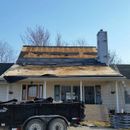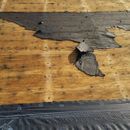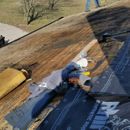Wet roof sheathing above open-cell spray foam
Recently I was called in to investigate a roof failure on a 6 year old remodel job (50+ year old house). The roof sheathing was rotting from the bottom side. The assembly and conditions were as follows.
Zone 4 Non-Marine (Kansas City)
Sheetrock, 2 x 6 cavities 24″ OC filled with .5lb Open Cell Foam, Plywood Sheathing, Synthetic Roof Under-layment, Architectural shingles. The roof slope transitioned from a 5:12 at the base, to an 10:12 approximately halfway up. Wettest part was right at the transition between roof pitches.
House was fully spray foamed, and likely should have had an ERV installed (Blower door test pending).
My conclusions were that the moisture levels in the home were elevated, Moisture migrated through the insulation during the winter, Condensation formed on the roof-deck, Moisture had no path to dry out, therefore deteriorating the plywood sheathing. (I have no reason to believe I am wrong, but welcome any corrections)
Now the serious questions.
1. Who should have spotted this? Builder, Inspector, HVAC contractor, Insulation contractor? All ,if they were thinking, could have spotted this, but did not.
2. What should be done?
ERV, Vented Over-Roof, Remove and replace insulation with Closed Cell Foam, Insulate above the roof sheathing, or something else.
3. Who will Pay?
I am just the consultant on this job and don’t have skin in the game, but I am being asked to pin the blame on someone (of course as long as it is not the builder who called me!)
Your advice and expertise are greatly appreciated as usual!
GBA Detail Library
A collection of one thousand construction details organized by climate and house part












Replies
There is /was a path to drying- but it's toward the interior. The peak moisture load levels from the cool roof deck in winter get to be too high unless there is a Class-II vapor retarder on the interior side of the open cell foam, and that gets aggravated if the homeowner is actively adding humidity in winter for comfort.
Both the inspector and insulation contractor should have known that it was a code violation. This type of thing isn't in HVAC contractor's wheel house- they're off the hook.
Since it's time to re-roof it's the right time to add insulation above the roof deck for both thermal and moisure performance. In zone 4A that needs to be at least 30% of the total R to be protect the roof deck from excessive moisture, more is better, and there still needs to be at least a Class-III (Class-II would be better) vapor retarder on the interior side of the open cell foam. So if there's R20 in the rafter bays you'll need at least R9 above the roof deck to have any margin, R12 or R15 would have a better shot at preventing recurrence if they're keeping the interior above 40% RH in winter.
A 2.5"-3" polyiso nailbase panel would be about right (R12-R15 ish) for preventing recurrence of moisture damage, but it's still less than IRC code-minimum thermal performance. A 3.5" nailbase panel might get it close to code-min on a U-factor basis. Typical examples of nailbase panels (there are others):
https://www.hunterpanels.com/product-documents/hpanels/speciality-products/108-h-shield-nb/file
https://roof.atlasrwi.com/products/acfoam-nailable-polyiso-roof-insulation/acfoam-nail-base/
While obviously this installation was a bad idea, I'm trying to find where it's a code violation in climate zone 4 per the IRC.
The relevant local codes of course might call it out as a violation. For example, I believe it would be a violation per the 2017 Oregon Residential Specialty Code, which is the one I'm familiar with. Perhaps it is also a violation in Kansas City, perhaps not.
But back to the IRC. IRC 2018 R806.5 requires that the air-impermeable insulation be a class II vapor retarder in climate zones 5-8, and requires a vapor diffusion port in climate zones 1-3, but doesn't seem to speak to zone 4. Any insights? I likely just missed something when I glanced over the section quickly. It certainly doesn't seem like it should be allowed.
Drying to the interior could only occur if the moisture level inside is lower than the moisture level in the cavity.
Unfortunately the new roof was being installed during my inspection.
Thinking about a smart vapor barrier material like Siga or Intelli-barrier on the interior side to still allow drying to the inside, but without an insulated nailbed it seems futile.
Jeff,
It's very possible to get a dramatic failure even when all details are code-compliant. I blame the following individuals: the designer (if there is one), the builder, and the spray foam contractor. They all should have known better.
Anyone who reads GBA would have known that open-cell spray foam installed on the underside of roof sheathing is risky and associated with damp roof sheathing.
We've been warning builders about this problem for years. For example, see these two articles:
"Open-Cell Spray Foam and Damp Roof Sheathing"
"High Humidity in Unvented Conditioned Attics"
Interesting that my spray foam installer 4-5 years ago never once mentioned anything about this. It was just OC vs CC cost/benefit decisions during my rehab. At what moisture levels are cause for concern in Massachusetts? I have steam heat and generally low humidity during the winter but do use a standalone humidifier- I doubt the house gets higher than 30-35% in the winter. Minisplits in the summer keep the house 45-50% in the summer..
Jeff,
It's not just here at GBA that this issue has been on the radar screen. Joe Lstiburek at Building Science Corp was talking about it at least 5-10 years ago. There have been a number of articles in both Fine Homebuilding and the Journal of Light Construction over the years discussing this type of failure with open cell foam.
The insulation also did not meet Code at the time of the installation, though local codes may differ. Kansas is on the IRC now, but you'll have to check whether it was on it 6 years ago, and whether they were on the 2009 or the 2012 IRC. By 2009, the insulation required in ceilings was R-38. Even if the cavities were filled with foam, that's only about R-20, and few foam installers actually fill the cavities. However, some jurisdictions adopt Rehab codes that allow less insulation in retrofit installations. So this insulation might have been allowed, but not optimum. Even so, the designer, builder and insulation contractor should have known better, as Dana said above.
Joe L. presented a very good detailed analysis of unvented attics in 2010. Go to building Science Corp and search for BSC-1001 "Moisture Safe Unvented Roof Systems." In that paper, he even used Kansas City as one of his test locations. You can read the whole thing, but the gist of it was that open cell spray foam (at the required R-38) was on the cusp of having mold/rot problems even when properly installed. Also, if there was high humidity inside the house it would be expected to fail.
If the roof has already gone on, your best bet would be to remove the ocSPF and replace it with ccSPF. That would work with all interior conditions, but still not meet 2009 IRC requirements at R-33. 2018 IRC requires R-49. A class II or III vapor retarder on the interior (asphalt-saturated kraft paper, latex paint, or smart vapor retarder) should be sufficient to prevent condensation even with the ocSPF, but not if the interior humidity is high.
It's pretty much impossible for anyone to accurately predict interior moisture levels. Ie, a house could be built completely correct and occupant behavior could cause it to fail.
Perhaps humidity alarms should be standard.
This is one of those cases where a moisture problem isn't about airflow (sheathing is in better shape near the rafters).
Oh, but it is still about airflow. Many of the investigations of moisture problems with ocSPF show that the ocSPF often develops large bubbles instead of an even "froth." Also, when applied at thicknesses of over 2"-3", it can be prone to shrinkage during curing that allows it to pull away from framing members. Both of these conditions allow direct airflow from the conditioned space to the roof.
The OP mentioned that the worst problems seem to be at the change of slope in the roof. I'll bet there is cross blocking there and that the foam has pulled away from the blocking slightly.
I will concede your point, though. Joe L's analysis shows that, even installed properly with no voids or gaps, ocSPF can fail in zone 4A. That's purely a diffusion failure, not an airflow failure.
Just got done a building investigation of an unvented roof assembly in CZ5A, open cell spray foam, deep, with voids, with very uneven depth, very high interior wintertime humidity, no vapor retarder at all.
The solution:
1. blower door/IR camera performance testing of insulation installation/repair
2. ventilate the cathedralized attic - I don't mean vent chutes to make the assembly vented; I mean supplying ventilation air to mix the air in the "semi-conditioned" cathedralized attic.
3. MEASURE humidity to maintain it at 35% or less in the winter - see this GBA resource:
https://www.greenbuildingadvisor.com/article/measuring-and-understanding-humidity.
In terms of unvented roof assemblies, climate zones, and the code: it has never been clear to me why the code is so detailed on exactly what to do with walls (continuous exterior insulation, vented claddings, and type of vapor retarder) and less clear with roofs. The code indeed does not reflect the need for connecting all of these for CZ4 and I believe it should, as Brendan states above.
Peter